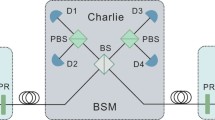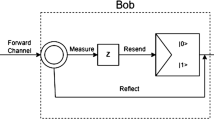Abstract
This paper characterizes two important properties of the photon number distribution of the heralded pair coherent state (HPCS) photon source. The formula of secret key generation rates for the decoy-state quantum key distribution with intensity fluctuation source is proved to hold true for the HPCS photon source. By numerical simulations, we show that the three-intensity decoy-state protocols for the HPCS photon source is efficiently getting close to the ideal decoy-state method. Moreover, we find that the HPCS source is more robust against intensity fluctuation than the weak coherent photon (WCP) source, but less stable than the heralded single photon source (HSPS).
Similar content being viewed by others
References
Bennett C H, Brassard G. Quantum cryptography: Publish-key distribution and coin tossing. In: Proceedings of the IEEE International Conference on Computers, Systems, and Signal Processing. Bangalore, 1984. 175
Raymond, Cai Y Q, Scarani V. Finite-key analysis for practical implementation of quantum key distribution. New J Phys, 2009, 11: 045024
Lu Z X, Yu L, Li K, et al. Reverse reconciliation for continuous variable quantum key distribution. Sci China Phys, Mech Astron, 2010, 53: 100–105
Gottesman D, Lo H K, Lutkenhaus N, et al. Security of quantum key distribution with imperfect devices. Quantum Information and Computation, 2004, 4: 325–360
Chen W, Han Z F, Mo X F, et al. Active phase compensation of quantum key distribution system. Chin Sci Bull, 2008, 53: 1310–1314
Qian X D, He G Q, Zeng G H. Realization of error correction and reconciliation of continuous quantum key distribution in detail. Sci China Ser F-Inf Sci, 2009, 52: 1598–1604
Xu F X, Chen W, Wang S, et al. Field experiment on a robust hierarchical metropolitan quantum cryptography network. Chin Sci Bull, 2009, 54: 2991–2997
Li C Z. Real applications of quantum communications in China. Chin Sci Bull, 2009, 54: 2976–2977
Wen H, Han Z F, Zhao Y B, et al. Multiple stochastic paths scheme on partially-trusted relay quantum key distribution network. Sci China Ser F-Inf Sci, 2009, 52: 18–22
Lo H K, Chau H F. Unconditional security of quantum key distribution over arbitrarily long distances. Science, 1999, 283: 2050
Shor P, Preskill J. Simple proof of security of the BB84 quantum key distribution protocol. Phys Rev Lett, 2001, 85: 441
Kraus B, Gisin N, Renner R. Lower and upper bounds on the secret key rate for QKD protocols using one-way classical communication. Phys Rev Lett, 2005, 95: 080501
Hwang W Y. Quantum key distribution with high loss: Toward global secure communication. Phys Rev Lett, 2003, 91: 057901
Koashi M. Unconditional security of coherent-state quantum key distribution with a strong phase reference pulse. Phys Rev Lett, 2004, 93: 120501
Dalvit D A R, de Matos Filho R L, Toscano F. Quantum metrology at the Heisenberg limit with ion traps. New J Phys, 2006, 8: 276
Scarani V, Acin A, Ribordy G, et al. Quantum cryptography protocols robust against photon number splitting attacks for weak laser pulses implementations. Phys Rev Lett, 2004, 92: 057901
Branciard C, Gisin N, Kraus B, et al. Security of two quantum cryptography protocols using the same four qubit states. Phys Rev A, 2005, 72: 032301
Lo H K, Ma X F, Chen K. Decoy state quantum key distribution. Phys Rev Lett, 2005, 94: 230504
Wang X B. Beating the PNS attack in practical quantum cryptography. Phys Rev Lett, 2005, 94: 230503
Wang X B. A decoy-state protocol for quantum cryptography with 4 intensities of coherent light. Phys Rev A, 2005, 72: 012322
Fung C H F, Tamaki K, Lo H K. Performance of two quantum-key-distribution protocols. Phys Rev A, 2006, 73: 012337
Horikiri T, Kobayashi T. Decoy state quantum key distribution with a photon number resolved heralded single photon source. Phys Rev A, 2006, 73: 032331
Zhang S L, Zou X B, Li C F, et al. A universal coherent source for quantum key distribution. Chin Sci Bull, 2009, 54: 1863–1871
Yin Z Q, Han Z F, Chen W, et al, Experimental decoy quantum key distribution up to 130 km fiber. Chin Phys Lett, 2008, 25: 3547
Chen T Y, Liang H, Liu Y, et al. Field test of a practical secure communication network with decoy-state quantum cryptography. Optics Express, 2009, 17: 6540–6549
Wang Q, Chen W, Xavier G, et al. Experimental decoy-state quantum key distribution with a sub-possionian heralded single-photon source. Phys Rev Lett, 2008, 100: 090501
Yin Z Q, Han Z F, Sun F W, et al. Decoy state quantum key distribution with modified coherent state. Phys Rev A, 2007, 76: 014304
Zhao Y, Qi B, Ma X F, et al. Experimental quantum key distribution with decoy states. Phys Rev Lett, 2006, 96: 070502
Wang X B, Peng C Z, Zhang J, et al. General theory of decoy-state quantum cryptography with source errors. Phys Rev A, 2008, 77: 042311
Wang X B, Yang L, Peng C Z, et al. Decoy-state quantum key distribution with both source errors and statistical fluctuations. New J Phys, 2009, 11: 075006
Wang S, Zhang S L, Li H W, et al. Decoy-state theory for the heralded single-photon source with intensity fluctuations. Phys Rev A, 2009, 79: 062309
Agarwal G S. Generation of pair coherent states and squeezing via the competition of four-wave mixing and amplified spontaneous emission. Phys Rev Lett, 1986, 57: 827–830
Usenko V C, Paris Matteo G A. Multiphoton communication in lossy channels with photon-number entangled states. Phys Rev A, 2007, 75: 043812
Author information
Authors and Affiliations
Corresponding author
Rights and permissions
About this article
Cite this article
Zhou, C., Bao, W. & Fu, X. Decoy-state quantum key distribution for the heralded pair coherent state photon source with intensity fluctuations. Sci. China Inf. Sci. 53, 2485–2494 (2010). https://doi.org/10.1007/s11432-010-4126-2
Received:
Accepted:
Published:
Issue Date:
DOI: https://doi.org/10.1007/s11432-010-4126-2




